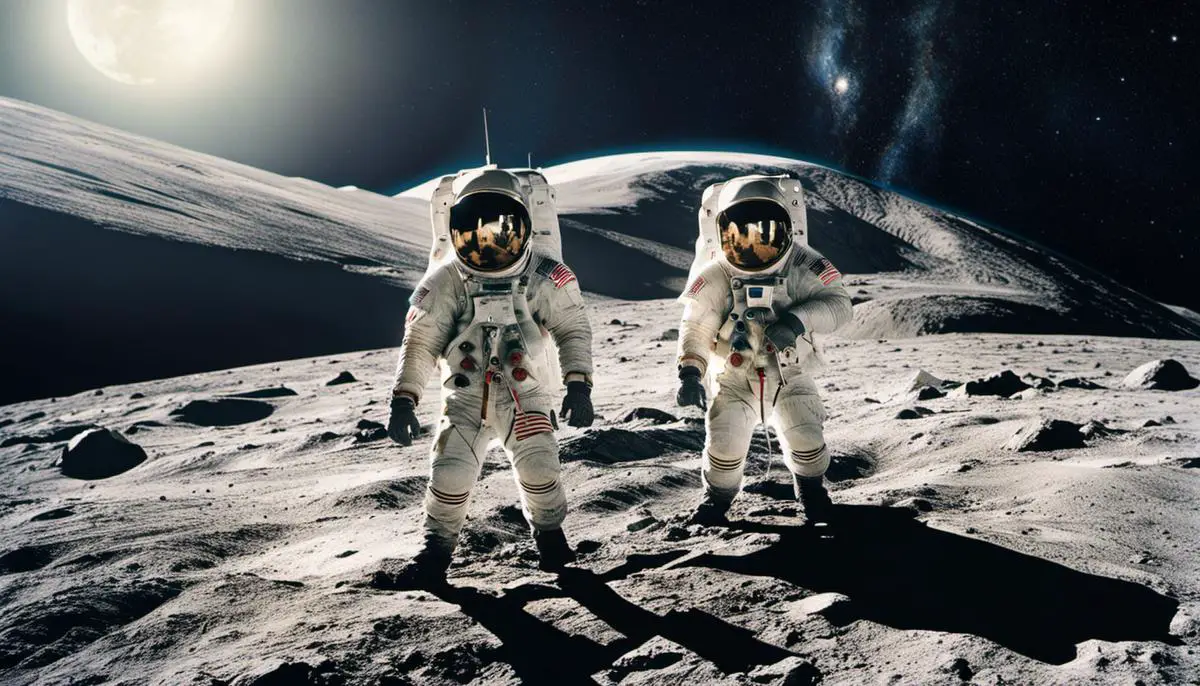In an unprecedented feat of human achievement and scientific advancement, the Apollo Mission series marked a significant milestone in the chronicles of space exploration. The audacity of astronauts to venture into the unknown, propelled by the vigor of human curiosity and the prowess of science, culminated into a narrative that commands global recognition today.
This narrative features the well-documented details of functional mission objectives, timelines, significant accomplishments, and the men behind the mission who dared the odds. Encapsulated within this narrative are the tales of intricate technologies employed– wherein spacecraft design, launch mechanisms, navigation knowledge, and much more, reign supreme.
Albeit these glorious tales, numerous conspiracy theories aim to cloud the authenticity of these missions. This journey into the vast realm of the Apollo Missions untangles fact from fiction and delves deeply into the conquest of Apollo, marked by the footprints left on the moon.
Contents
Overview of the Apollo Missions
Apollo Program: Beginnings and Objectives
The Apollo Program was an initiative of the United States’ National Aeronautics and Space Administration (NASA) and ran from 1961 to 1972. Its primary objectives, as outlined by President John F. Kennedy, were focused on the goal of landing a man on the moon and safely returning him to Earth before the decade was out.
Named after Apollo, the Greek god of the Sun, the Apollo program not only set its sights on lunar exploration but also included studies aimed at understanding both the moon and the cislunar space.
Key Timelines and Milestones
The program formally began with the launch of Apollo 1 in February 1967, which tragically ended in a cabin fire resulting in the deaths of three astronauts during a pre-launch test. After overcoming this initial setback, NASA achieved multiple significant milestones. There were a total of 17 Apollo missions, six of which (Apollo 11 to Apollo 17, excluding Apollo 13) successfully landed on the moon.
Apollo 8 (December 1968) was the first crewed spacecraft to orbit the moon. Apollo 11 (July 1969), perhaps the most famous of the missions, saw astronauts Neil Armstrong and Buzz Aldrin become the first humans to set foot on the lunar surface.
This was a seminal moment in human history and remains a powerful symbol of what scientific endeavor and exploration can achieve.
Significance and Global Impact
The impact of the Apollo Program was truly global, both in its practical scientific outcomes and symbolism. In scientific terms, the Apollo missions returned a wealth of data about the Moon’s surface and geological composition. For instance, the rock and soil samples collected during these missions have proven invaluable in advancing understanding of the moon’s formation and history.
Symbolically, the Apollo Program represented the apex of the Space Race, the Cold War competition between the United States and the Soviet Union for supremacy in space exploration. The image of a man walking on the moon signified technological advancement, human achievement, and national pride. It served also to inspire generations to dream, to explore, and to believe in the seemingly impossible.
The Astronauts of Apollo
A total of 24 astronauts flew to the moon as part of the Apollo program, twelve of whom walked on its surface. They included engineers, test pilots, and a geologist.
Some of the most well-known Apollo astronauts include Neil Armstrong and Buzz Aldrin (Apollo 11), Alan Shepard (Apollo 14, who was also the first American in space), Edgar Mitchell (Apollo 14), and Harrison Schmitt (Apollo 17, a professional geologist and last man on the moon).
Off the back of the outstanding feats achieved by the Apollo Program, several conspiracy theories have been spouted. These theories allege that the U.S. government and NASA orchestrated the moon landings as hoaxes.
Among these claims, the most prevalent include speculations that the moon photographs were either artificially created or manipulated in a studio, that the Van Allen radiation belts would have been impossible for the astronauts to traverse, and that the Space Race was a determinant factor in the U.S. faking the moon landings.
However, such theories have been repeatedly discredited by NASA and a plethora of experts. They present overwhelming evidence debunking these claims, including independent confirmations of the moon landings numbering in the thousands, moon rocks retrieved and brought back to Earth, and unbiased tracking of the Apollo missions. Nonetheless, these conspiracy theories still manage to find believers in some circles.
The Science & Technology Behind Apollo Missions
The Apollo missions stand as a momentous technological milestone in humanity’s rich history. One notable demonstration of this is the design of the spacecraft.
It was divided into three key sections: the command module (CM), which served as the astronauts’ main living and working space; the service module (SM), providing storage for life support equipment; and the lunar module (LM), designed specifically to ferry two astronauts to and from the moon’s surface.
The lunar module, in particular, was an object of technological wonder. It was an exclusively crafted vessel, dedicated to landing on the moon and then launching back into space. The lunar module was equipped with descent and ascent stages.
The descent stage was responsible for managing the landing, housing all the necessary equipment. The ascent stage, on the other hand, functioned as the vehicle for departing from the moon’s surface.
The launch vehicle used for the missions was known as the Saturn V rocket. Assembled from over three million parts, it stood at a height of over 360 feet. It was designed to release the Apollo spacecraft into the earth’s orbit and then to propel it towards the moon. The rocket consisted of three stages, each with its engines and fuel.
This staging mechanism – where each part of the rocket falls away when its job is done – was crucial to get the spacecraft moving fast enough to leave the earth’s gravity.
Determining the correct flight trajectory and navigating through space was perhaps the most challenging part of the mission. This was accomplished through a complex series of burns, called trans-lunar injection, to set the spacecraft on a course towards the moon.
Another crucial process was the lunar orbit insertion, where the command and service modules were slowed down enough to be captured by the moon’s gravitation pull.
The Apollo space suits were next-level feats of technological sophistication. They were self-contained environments, providing astronauts with life support, protection from space radiation, and mobility for walking, climbing, and sitting in the lunar module.
Underneath the suit, they wore a liquid cooling garment, which kept them comfortable and prohibited overheating, which is a common concern in a spacecraft.
The moon landing technology was another highlight of the Apollo mission. The astronauts used the lunar module’s descent engine to slow their course and touch the moon gently.
The lunar module was equipped with a contact light that lit up when sensors on the probe touched the moon’s surface, indicating to the pilot when to shut down the descent engine.
The Apollo missions were not just technological demonstrations. Serious science was done on the moon’s surface, changing our understanding of the moon and the solar system.
Apollo astronauts surveyed the lunar surface, collected moon rocks and soil samples, and set up a series of scientific experiments. These samples and data have proffered invaluable insights into lunar geology, drastically transforming theories about the moon’s formation and geologic processes.
Conspiracy theories, particularly the suggestion that the moon landing was a well-orchestrated hoax, have stubbornly persisted despite a wealth of factual evidence and remarkable scientific advancements.
Nonetheless, the myriad physical evidence brought back from the moon, the extensive cache of photographs from the missions, the personal testimonies from the huge workforce involved in the project, and the rigorous verification of the missions by numerous independent entities collectively discredit these speculative claims.
A resounding majority of the scientific and academic community unambiguously affirm the veracity of the Apollo moon landings.
Apollo Missions Conspiracy Theories
The Flag’s Anomalous Manner
A widely propagated conspiracy theory associated with the Apollo missions pertains to the behavior of the American flag installed on the lunar surface by the Apollo astronauts. Skeptics point to footage and pictures from the Apollo 11 mission where the flag appears to flutter, an impossibility given the moon’s lack of atmosphere and subsequent absence of wind.
This apparent contradiction has spawned an ongoing debate among conspiracy theorists, who suggest either the flag had hidden wire supports or that the entire tableau was an elaborate setup filmed in a TV studio.
Photo and Video Inconsistencies
Another premise often used by conspiracists to challenge the authenticity of the Apollo missions pertains to perceived inconsistencies and irregularities in the photos and videos released by NASA. Critics argue that the lighting and shadow effects in some images appear unnatural, with objects in shadow being too clearly visible.
Others claim that despite the moon’s dust-covered surface, the lunar module left no blast crater or any sign of dust disturbance upon landing. Some even analyze the crosshairs in the photos, suggesting that they appear behind objects, which they argue would be impossible if the photos were genuine.
Radiation Belts and Human Survival
The Van Allen radiation belts surrounding the Earth are another source of contention for Apollo doubters. These belts trap solar radiation and present a potential risk to humans passing through them.
Conspiracy theorists propose that the Apollo astronauts, with the technology available in the 1960s, could not have safely navigated through these radiation belts. However, according to NASA and multiple scientific communities, the astronauts’ rapid passage through the belts coupled with their shielded spacecraft kept their exposure well within safe limits.
Not a Single Star in Sight
The absence of stars in the photographs taken during the lunar missions is another anomaly often cited by conspiracy theorists. They argue that the stars should be clearly visible and extraordinarily bright due to the lack of atmospheric interference on the moon.
This argument, however, neglects to consider the particularities of photographic exposure. Given the bright sunlight on the moon, the camera settings used to capture the lunar landscape would have rendered the relatively faint stars invisible.
Unexplained Deaths Associated with Apollo
Some conspiracy theorists link a series of premature deaths of people connected to the Apollo program as part of an orchestrated effort to keep supposed truths about the moon landing hidden.
The C’s of individuals include astronauts, aerospace engineers, and even a television broadcaster who publicly expressed doubts about the moon landing. While these deaths were officially attributed to accidents, illness, or suicide, conspiracy theorists propose they may be part of a cover-up.
Keep in mind that many of the so-called ‘truths’ behind the conspiracy theories surrounding the Apollo moon missions are not supported by factual evidence.
Despite continuous propagation of these theories, the scientific community around the globe has dismissed them. The scientific consensus upholds the narrative that the Apollo program did triumphantly achieve the landing of men on the moon between 1969 and 1972.
Debunking the Conspiracy Theories
Unravelling the Incoherencies in Apollo Conspiracy Theories
A prevalent conspiracy theory alleges that the Apollo moon missions were all a facade, enacted on a Hollywood sound stage instead of the lunar surface.
Suspicions were raised due to seeming anomalies in the mission’s photos and films, such as the absence of stars in the night sky and the sight of the American flag seemingly fluttering– all of which would not be possible in the moon’s airless environment.
In spite of their popularity, it’s valuable to understand that these observations are not backed by scientific reasoning.
To illustrate, the missing stars can be explained by the contrast difference between the radiantly sunlit moon surface and the distant stars, causing the stars to be too faint to appear on the camera films used by the Apollo astronauts. Additionally, the television camera technology of the time could not simultaneously capture the brightly lit lunar surface and the faint stars.
Regarding the controversy of the ‘fluttering’ American flag, it was affixed on a horizontal arm designed to hold the flag out for full display.
This created the illusion of a fluttering flag. When the astronauts were installing the flagpole into the moon’s crust, the flag’s movement persisted for a while longer due to the low gravity and lack of air resistance on the moon, subsequently resulting in the illusion of a ‘fluttering’ flag in the photographs.
The Van Allen Radiation Belt Defense
Another prevalent conspiracy theory is that manned missions to the moon would have been impossible due to the dangerous levels of radiation in the Van Allen belts, which encircle Earth. This theory states that astronauts would have died from the extreme exposure.
However, this claim can be readily debunked by understanding the nature of the Van Allen belts themselves and the precautionary measures taken by NASA. The Apollo spacecraft traveled through the thinnest parts of the belts in a swift, curved trajectory to reduce the time spent in radiation fields, and the astronauts were adequately shielded, hence they received doses well within the accepted standards of radiation exposure.
Expert Statements and Astronaut Testimonies
Additionally, hundreds of thousands of people across the globe watched the moon landing on live television, including astronomers and scientists who would have immediately spotted any signs of forgery.
All the Apollo Moon missions were tracked by multiple independent organizations, such as the British and Soviet Union tracking stations, which confirmed their authenticity.
Moreover, the moon rocks brought back by Apollo astronauts are significantly different from any rocks on Earth – in their isotopic composition, mineralogy, and age. These rocks have provided valuable new insights into the history and composition of the moon and are still studied by scientists today, a clear testament to the mission’s authenticity.
Lastly, all astronauts who have walked on the Moon during Apollo missions fervently deny any fabrications. Buzz Aldrin, the second man to walk on the Moon, confidently stated, “We went to the Moon. We walked around there, and we came back. We did it six times, and that’s all there is to it.”

As we traverse the contours of fact and conspiracy with an open mind, guided by the compass of available scientific evidence and testimonies, the compelling nature of the authenticity of the Apollo Missions takes form.
The astronauts’ testimonies, the meticulous record of mission details, the considerable evidence against prominent conspiracy theories, all converge into an undeniable testament of mankind’s victory over the moon.
The Apollo Missions stand tall in the pages of human history, a testament to our aptitude for exceeding boundaries, embracing the unknown, and leaving an indelible imprint on the canvas of the universe.
It offers a powerful reminder that when we speak of the moon, we talk not just of a celestial body in the night sky, but of an epoch where humanity, with its science and spirit, ventured to touch the untouched and made it a part of our collective human story.

With a passion for unraveling the mysteries of the moon, Dr. Luna Sterling is a highly-respected astrophysicist, a dedicated lunar enthusiast, and a captivating blogger. After earning her Ph.D. in Astrophysics from the Massachusetts Institute of Technology (MIT), she served as a lead scientist and mission planner for NASA, contributing significantly to various lunar missions.
For over two decades, Luna has been at the forefront of lunar science, pushing boundaries and pioneering discoveries that have enriched our understanding of the moon’s geological history. However, it’s her infectious enthusiasm for all things lunar that truly sets her apart.
In an endeavor to bring the moon closer to everyone, Luna started her blog, “Luna’s Lens: A Closer Look at the Moon.” With this platform, she offers a unique blend of intriguing moon facts, updates on lunar missions, and personal anecdotes from her experiences in the field, all told in an engaging and accessible manner.
Luna’s unique blend of scientific expertise and warm, humorous writing style has transformed complex astrophysics into compelling narratives that captivate her audience. As a gifted communicator, she leverages her knowledge and experience to relate scientific facts to everyday life, thus making her blog a must-read for both seasoned space enthusiasts and curious newcomers.
Interactive and inviting, Luna frequently encourages reader engagement through thought-provoking discussions and a monthly ‘Ask Dr. Luna’ feature, where she personally answers questions about the moon and space exploration. A celestial storyteller at heart, Dr. Luna Sterling’s passion for the moon is as vast as the cosmos she explores, making her an invaluable beacon in the world of lunar science.
